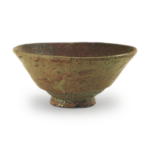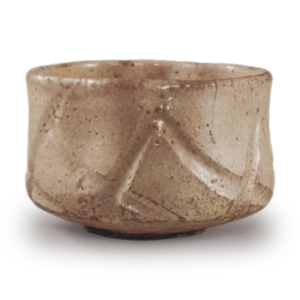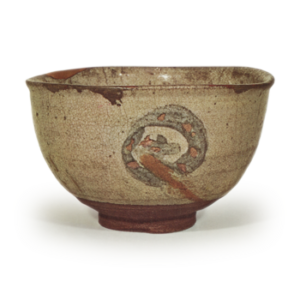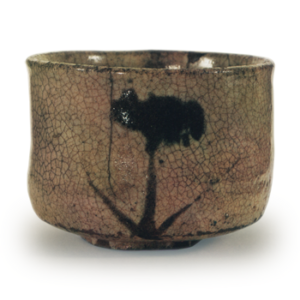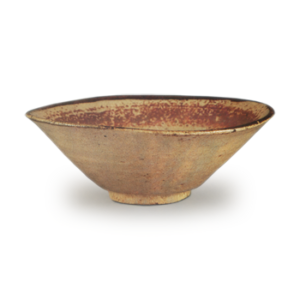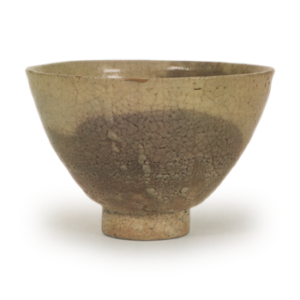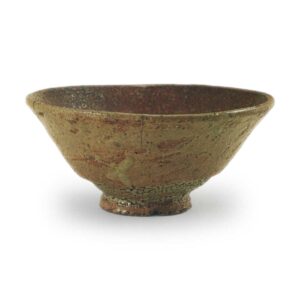
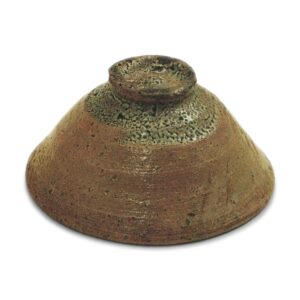
Meibutsu
Height: 6.0 – 6.3 cm
Diameter: 13.4 – 13.5 cm
Outer diameter of foot ring: 4.0 – 5.0 cm
Height of foot ring: 0.9 cm
This tea bowl was originally in the collection of the Osaka merchant Inagawa Yasuemon of the Ibarakiya store, and was a highly regarded tea bowl with no signature, known as the “Ibarakiya no Mu-mei” (Ibarakiya’s unsigned). It was passed into the hands of Ikushima Kazo during the Meiji Restoration, and was named Hayato by Prince Sadanobu of the Fushimi-no-miya family. The name Hayato was probably given to this tea bowl because of its sharp, slender shape, from the foot to the rim of the mouth.
There are two types of Aoido tea bowls: those that are easy to recognize at first glance, and those that are so difficult to understand that you can’t get inside them just by looking at them once. Aoido tea bowls tend to belong to the latter category. Therefore, Aoido tea bowls that are small and have a tight finish are popular. In this respect, Hayato is light to hold and is one of the smallest Aoido tea bowls.
Apart from the fact that the grinding from the foot ring to the waist is perfectly straight, the wheel-throwing is not too rough, and the water-drawing marks can be seen, so the workmanship is extremely elegant.
The glaze is a so-called reddish loquat-colored glaze that can be seen through the greenish blue glaze that is characteristic of Aido ware. There are also areas where the glaze is uneven or has broken off, and the kaaragi (a type of pattern) that runs from the waist down to the rim of the foot is particularly beautiful with its hint of blue. This is the first highlight of this tea bowl.
The foot of the bowl is thin and open, giving the impression of a hawk standing on its feet. The inside of the foot ring is also covered in kaigai glaze, and there are five marks where the tatami mat was attached.
The inside of the bowl is marked with a distinct potter’s wheel mark near the bottom, and the center is also marked with a plum-blossom skin glaze. In addition, the five marks and the cracks from the firing process add to the beauty of the bowl, and the tea stains around the rim in particular show the care and attention of the tea master who cherished this bowl. In addition to the broken part on the side, there is a so-called “nyu-ga” (a small piece of clay attached to the side of the bowl to strengthen it).
The bowl was originally owned by the old Osaka family, Ibaragiya Inagawa Yasuemon, and was an unmarked bowl at the time, but it was passed on to Ikushima Kizo during the Meiji Restoration, and in 1905, when Ikushima held a tea ceremony at his Kyoto villa, Yoroen, villa, Yoroen, a tea party was held, and Prince Sadanari Fushimi and Murakumo Monzeki visited. At that time, Prince Fushimi asked for an inscription, and the tea bowl was named Hayato.
After that, it passed through the hands of Toda Rosho of Ichigenan, then to the Taneyama family, and then to the collection of Masuda Dono, but in 1920 it was displayed at the Sōan tea ceremony house in Odawara.
The writing on the inside of the lid of the outer box is by Prince Sadanori Fushimi, and the writing on the lid of the inner box, “Koryo tea bowl”, is by the Murakumo Monzeki, while the writing on the reverse of the lid is by Yabunouchi Kyukyusai and Chikusui.
There are also three accompanying letters: a letter from the Fushimi-no-miya family to Ikushima in May 1905, a letter from Toda Rosho to Taneyama in April 1919, and a letter from Rosho to Takahashi Taian.

